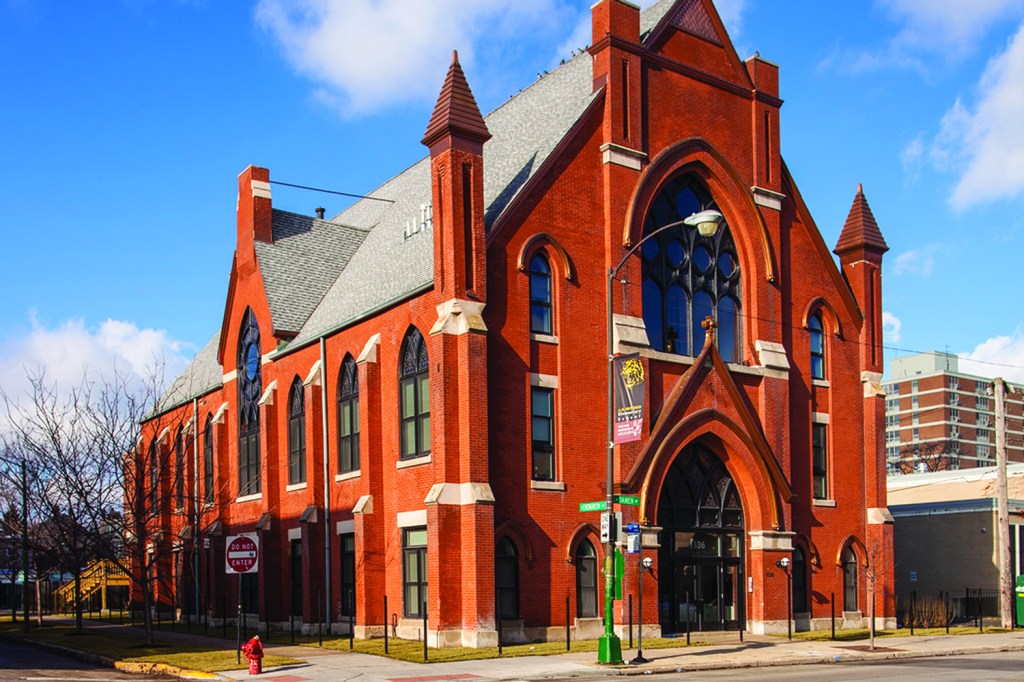From motels and churches to bowling alleys and factories, buildings of all types eventually reach the end of their “natural” functioning lives. Whether to fill an otherwise overlooked market niche, provide affordable housing where it’s most needed, or accommodate a group of talented Millennials with big visions but meager means, adaptive reuse projects are meaningful investments with promising returns. They represent both important opportunities for the design community—and an ever-important role in cities that need to adapt to the future.
Everman Lofts
A project in Chicago recently saw the transformation of the Chicago Missionary Society Church, located in the heart of Wicker Park, a neighborhood originally settled by steelworkers in the late 1800s. Today, the building is home to 11 market-rate rental units known as Everman Lofts.
“Many churches are landmarks, protected from demolition, but no plan was ever considered as to what to do with them when their use expires,” explains Jean Dufresne, AIA, a principal with Space Architects + Planners. “They’re old and in disrepair, and congregations are long gone or are so small that they can’t maintain the buildings. On a grander scale, the Catholic Church is planning on closing hundreds of buildings due to rising costs and lack of attendance.”
James D. Jann, the developer who converted the Chicago Missionary Society Church into dwelling units, says that “during the process of restoring the 135-year-old stained glass windows, I was approached by a neighbor who said he’d lived across the street for 10 years and just wanted to say ‘thank you’ for making the view out his front window such a pleasure.”
But, the view from inside may be better, according to one resident: “My husband and I wanted a unique place to live and found an amazing space in this beautifully rehabbed church, with soaring ceilings and beautiful stained glass windows to frame our view.”
The Lofts at Albuquerque High
Albuquerque, N.M.’s first high school was a commanding 1914 Collegiate Gothic–style building that closed in 1974 and stood vacant for the next 25 years at a major intersection near downtown. In 1999, the city awarded a development contract to Albuquerque’s Paradigm & Company.
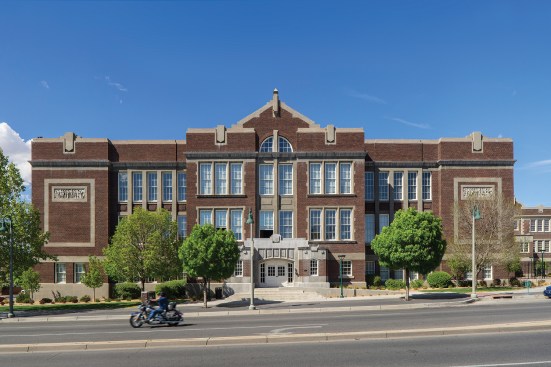
Photography: Michael Baxter
Albuquerque’s first high school sat vacant for 25 years before it was converted into 249 condominiums, now known as the Lofts at Albuquerque High.
“The biggest construction challenges were … building new space inside of the old volumes of the auditorium and the gymnasium,” says Rob Dickson, project developer for the Lofts at Albuquerque High. “In the case of the former, we built 15 lofts and were allowed to connect the new structure to the old. With the latter, we constructed 20 lofts into the former gym, but seismic code interpretation required them to be an independent structure.” Built in eight separate phases, from 2001 to 2009, the project created 249 residential condominiums and a parking structure. The historic building looks exactly the same from outside. “Immediately upon construction, the entire perception of this neighborhood improved,” Dickson says. “This is why there have been hundreds of millions of dollars invested into renovating existing homes and former commercial buildings throughout the neighborhood.”
Hubbard Street Lofts
In general, Chicago has been experiencing a major re-urbanization during the last 20 years, according to Ramiel Kenoun, AIA, another principal with Space Architects + Planners. “When I was growing up, Chicago, specifically downtown and its immediate surrounding areas, was a place you went to work every day, not to live in,” he says. “Now young professionals are opting to stay within city limits.”
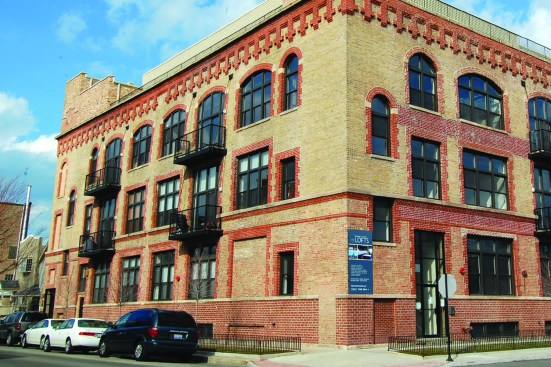
Photography: Mike Schwartz
The 43,000-square-foot napkin factory is now the site of 21 residences in the Hubbard Street Lofts.
Kenoun recently served as project architect on the conversion of a 43,000-square-foot napkin factory at the Fulton Market District, once primarily occupied by the meatpacking industry. The Italianate façade combines some of the quirkier details of century-old revival stylings with some unconventional fenestration. Costing around $3 million and taking about two years, Hubbard Street Lofts now features 21 condos. “Being a resident of the area for over 12 years and seeing a big shift in what was primarily a manufacturing district to a residential neighborhood has been an extremely positive experience,” Kenoun says. “The mixture of new and old structures, along with the unique infrastructure, such as elevated walkways, railways, viaducts, and other architecturally interesting elements, has made it into a residential community like no other.”
Meow Wolf
Santa Fe is a renowned arts hub, but rarely do visitors see the industrial area where Silva Lanes, a 1970s-era bowling alley, had been shuttered for seven years. Today the building’s simple white façade belies the activities there of a group of young entrepreneurial artists who realized their collective vision, thanks to writer George R.R. Martin, author of the Game of Thrones series. After hearing the group’s plan, Martin purchased the building, financed renovations, and leased it for 10 years to the Meow Wolf Art Space, which opened in 2015 and hosted 25,000 visitors in the first two weeks.
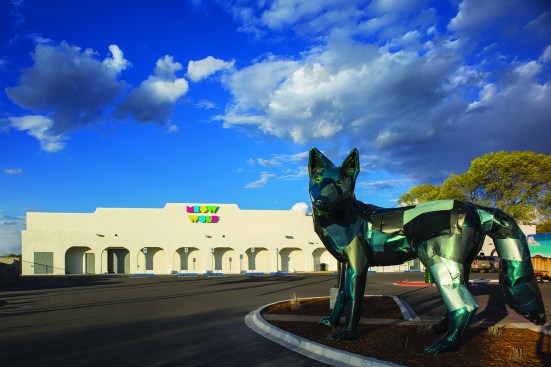
Photography: Michael Baxter
Once a 1970s-era bowling alley, Meow Wolf is now a 33,000-square-foot community arts space in Santa Fe.
“The 33,000-square-foot community arts space includes galleries and workshops, member-supported maker spaces,” says Alexander Dzurec, AIA, the founder and managing principal of Autotroph Design, who worked with a core creative team from Meow Wolf on the renovation. “[The space] employs over 200 artists, fabricators, and tech experts to create an out-of-this-world experience for both young and old, connoisseur and layperson alike.”
“We’re building upon solid roots,” says Sean Di Ianni, Meow Wolf ’s chief operating officer. “We’re expanding Santa Fe’s identity as a place to see art and culture.”
The Sundowner
The Sundowner Motel in Albuquerque, built in 1960 and shuttered in 2009, was a two-story midcentury modern affair with a pool, casino, and dance floor. Vintage postcards depict what could pass for a swanky backdrop to a Mad Men episode.
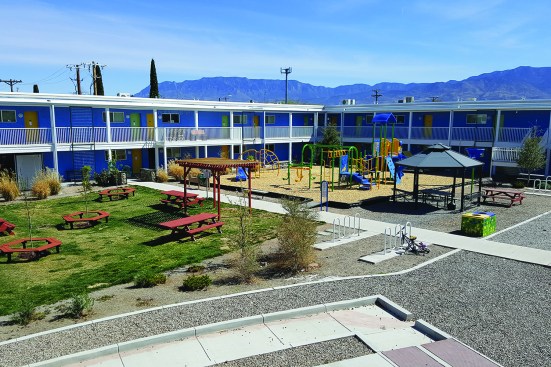
Photography: Courtesy of NewLife Homes
A $9 million renovation converted the Sundowner, a 1960s motel, into 71 residential units for both low-income and market-rate tenants.
In 2013, a $9-million renovation project retained much of the building’s early mod aesthetics and created 71 residential units, the majority reserved for individuals making less than half of the local median income.
“As with many urban areas in decline, nonprofit partnerships bring the first new development in years,” says Garrett Smith, AIA. “[They] provide new housing for local residents—Boomers and Millennials, and those in most need—who support walking-distance businesses and public transportation, which begins the process of neighborhood revitalization.”
The project achieved LEED-Platinum certification with several conservation features, including permeable parking areas that direct water for landscaping and water-harvesting cisterns for a community garden.
